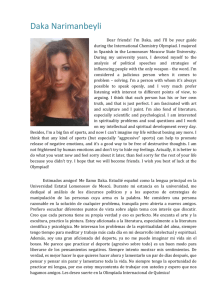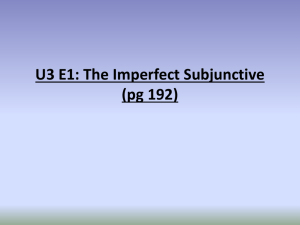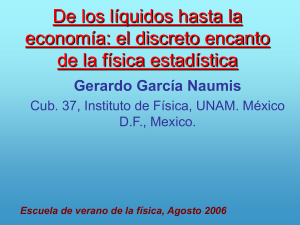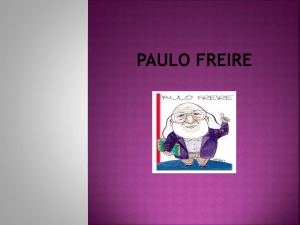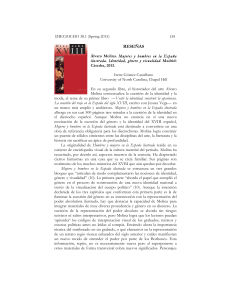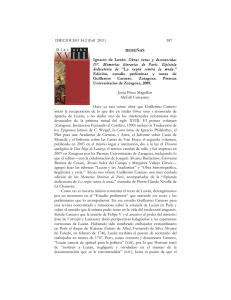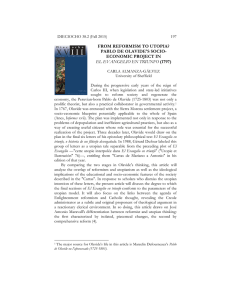Document 14174318
advertisement
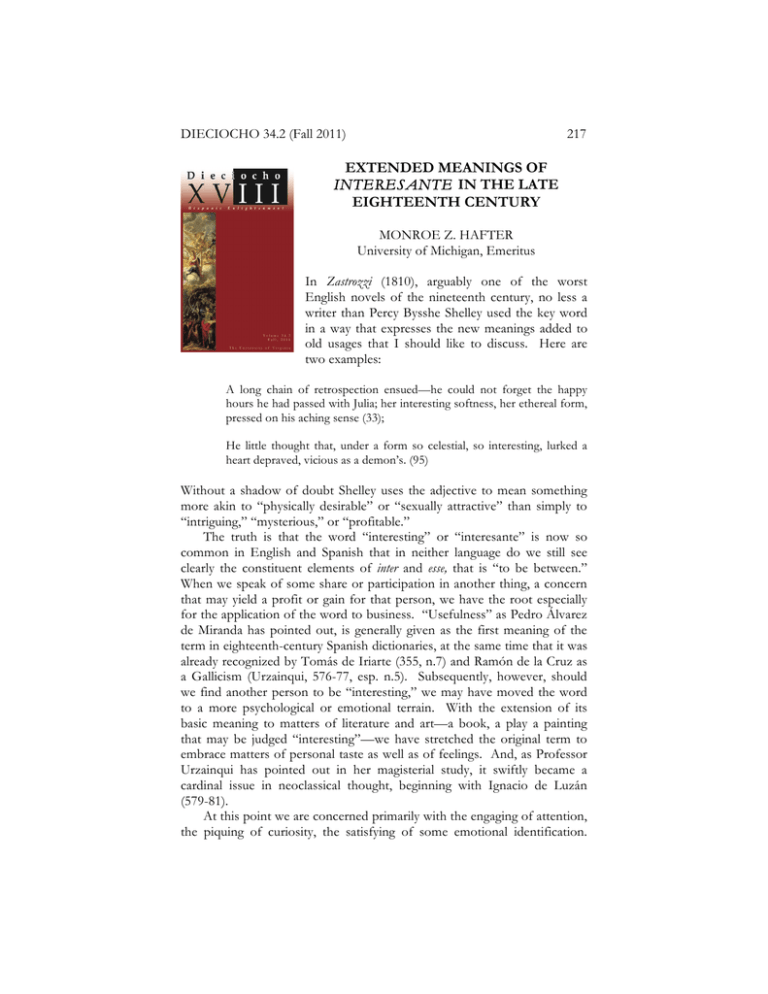
DIECIOCHO 34.2 (Fall 2011) 217 EXTENDED MEANINGS OF INTERESANTE IN THE LATE EIGHTEENTH CENTURY MONROE Z. HAFTER University of Michigan, Emeritus In Zastrozzi (1810), arguably one of the worst English novels of the nineteenth century, no less a writer than Percy Bysshe Shelley used the key word in a way that expresses the new meanings added to old usages that I should like to discuss. Here are two examples: A long chain of retrospection ensued—he could not forget the happy hours he had passed with Julia; her interesting softness, her ethereal form, pressed on his aching sense (33); He little thought that, under a form so celestial, so interesting, lurked a heart depraved, vicious as a demon’s. (95) Without a shadow of doubt Shelley uses the adjective to mean something more akin to “physically desirable” or “sexually attractive” than simply to “intriguing,” “mysterious,” or “profitable.” The truth is that the word “interesting” or “interesante” is now so common in English and Spanish that in neither language do we still see clearly the constituent elements of inter and esse, that is “to be between.” When we speak of some share or participation in another thing, a concern that may yield a profit or gain for that person, we have the root especially for the application of the word to business. “Usefulness” as Pedro Álvarez de Miranda has pointed out, is generally given as the first meaning of the term in eighteenth-century Spanish dictionaries, at the same time that it was already recognized by Tomás de Iriarte (355, n.7) and Ramón de la Cruz as a Gallicism (Urzainqui, 576-77, esp. n.5). Subsequently, however, should we find another person to be “interesting,” we may have moved the word to a more psychological or emotional terrain. With the extension of its basic meaning to matters of literature and art—a book, a play a painting that may be judged “interesting”—we have stretched the original term to embrace matters of personal taste as well as of feelings. And, as Professor Urzainqui has pointed out in her magisterial study, it swiftly became a cardinal issue in neoclassical thought, beginning with Ignacio de Luzán (579-81). At this point we are concerned primarily with the engaging of attention, the piquing of curiosity, the satisfying of some emotional identification. 218 Hafter, “Extended meanings of interesante” Finally, when the term is used to designate the specific allure of one of the opposite sex, then with esthetics and attraction we almost certainly are remarking erotic, or emotional, interests. To be sure, such interests are not far removed from the desires for personal gain with which we started, but at a very different level and changed context. All of these meanings came into force for interesante in eighteenth-century Spain. References abound throughout the century to document the primary meaning of this term. That moralizing story teller, Ignacio García Malo leaves no doubt in the reader’s mind when he couples the following two nouns in one of his narratives, “¡Cuánto pueden el interés y la avaricia!” (Voz de la naturaleza, 359). Nor is Vicente del Seyxo, for another example, any less clear when he declares in his Ensayos políticos (1798), El interés es el más grande resorte que mueve al corazón humano, pero pide una atención muy escrupulosa para emplear este primer principio de las acciones del hombre; porque viciada la naturaleza, las máquinas de su movimiento lo serán también. El interés de las riquezas debe distinguirse del amor, de la estimación de la gloria. (49) And the word remains perfectly comprehensible, though strangely invoked when it appears at the end of Samaniego’s fable, “La comadreja y los ratones” (1781). The author honors the aged and hungry weasel who used her wits to catch new prey, generalizing: “Es feliz un ingenio interesante: / El nos ayuda, si el poder nos deja…” (Fábulas, 154). Clearly the adjective here means something like “clever,” “helpful,” “resourceful,” but always in the context of “self-serving.” I should like now to draw in a text that is especially noteworthy because it opens up an ambiguity that leads into a new semantic field. It comes at an early point in Torres Villarroel’s autobiography (1743) when he warns the reader to avoid the wicked actions narrated and to learn from the good examples. He writes: …cuando no lee sus acciones el ansia de imitar las unas y la buena intención de aborrecer las otras, sino el ocio impertinente y la curiosidad mal empleada. Lo que yo sospecho es, que si este estilo produce algún interés, lo lleva solo el que escribe, porque el muerto y el lector pagan el contado, el uno con los huesos, que le desentierran, y el otro con su dinero. (Vida, 114-15) The following quotations – and Professor Urzainqui has thoroughly studied many others documenting esthetic concerns of the eighteenth century – pick up the foregoing ambiguity to increase the small movement beyond personal gain to a second meaning. I am referring now to what might prove to become usefully instructive, but also pleasurable or intellectually satisfying. The anonymous author of El Tío Gil Mamuco DIECIOCHO 34.2 (Fall 2011) 219 (1789), a book imitating Don Quijote, wrote in the prefatory remarks: “…digo que me alegrara que esta narración verídica de las empresas divertidas del memorable Tío Gil Mamuco, que concluí ayer viernes por la noche, diera el mayor interés y pro: de algún interés o diversión confío, pero no de ninguna pro; porque tengo experiencia del corazón humano y del carácter nacional” (iii). A few pages later he confirms the connection by repeating how what is useful can engage the attention of the reader: teniendo por la cosa más precisa el introducir y aumentar la aplicación así en orden a las obras útiles mecánicas, y que no se hacían en el Reyno, como a los estudios más interesantes e instructivos…” (8). Vicente Martínez Colomer reaffirms this joining of pleasure and useful instruction to “interesting” in the prologue to his book (1795), by writing, “…y al mismo paso debe [un buen narrador de historia] instruir, deleitar, mover e interesar, uniendo el placer y la ilusión al fruto y la utilidad. (El impío por vanidad, n.p.) It would seem that we can move, in our consideration of the semantic values of interesar, from what is useful for or engaging to oneself to a less self-centered range of meaning, that is, useful to others, the holding of another’s attention, the exchange of concerns. Written in the concluding years of the eighteenth century, Luis Gutiérrez, apparently the anonymous author of the extraordinary, anti-clerical novel, Cornelia Bororquía (Paris, 1801), addresses this exactly: Hay en un corazón ingenuo ciertas fibras que se conmueven con mucha facilidad y que corresponden en cierto modo a las de los corazones que se le asemejan; y una vez establecidas las relaciones de analogía, una vez que se ha encontrado el punto de contacto, resulte entre ellos un concierto dulce e interesante. (148) Further evidence of the psychological and affective bases our Word has moved to comes a few pages later in the same novel. The author describes a point of contact far removed from avarice or self-interest when he writes: “La destreza y gracia con que tocaba la zagala, su voz dulce y melodiosa, y un cierto aire de interés que ella daba a sus palabras, todo concurrió a llamar mi atención por un momento…” (154). It is significant that in both instances of the use of “interes[ante],” the word is joined to dulce, as if the sweetness of the voice induced a feeling of harmony between the two individuals. The passage suggests that the interest that one person has in another rests on a basis of sympathetic feelings, although not restricted always to music. This may prove to be the meaning, about thirty years later, of the somewhat enigmatic signature of the author of La filósofa en el Tajo (1830), at the end of the dedication to his cousin. He concludes the offering of this 220 Hafter, “Extended meanings of interesante” supposedly modest work as emanating from “Su interesante primo, José López Escovar y Carbonera.” The most likely understanding of his calling himself “interesting” must consist of something akin to “sympathetic” or “caring,” or, in other words, “interested in you.” In this way, the word interesante enlarges its semantic value and thus gives further evidence of the growing sensibility that manifests itself towards the end of the eighteenth century. We see how evident this becomes in passages from books published in the 1790’s. In the first, a dead poet’s advocate addresses a possible publisher to win support for this posthumous volume of poems (1793): “Para dar un aire de ternura y delicadeza mayor a las composiciones de esta clase, Iglesias las pone casi siempre en boca del sexo más débil, y de consiguiente más interesante cuando sufre” (Iglesias de la Casa, I, x). And Pedro Montengón (1795) follows in line with his recourse to the key word in the following quotations: Mas viendo que continuaba [la vieja madre] en llorar, entró del todo en la cueva para confortarla, diciéndola: “¡Cuánto me interesa ese vuestro llanto!” (El Mirtilo, 316); …decid qué queréis que haga, pues aunque sumamente me intereso por vos, y por Melanía … . (Ibid, 320); No podía Mirtilo infundir mayor interés de afecto, y de confianza, en el ánimo de Melanía, que el que la daba con aquellas palabras, y con el afectuoso y resoluto tono con que las profería. Era sobrado interesable aquella generosa opción para una mujer que se hallaba allí sola tantos años … .(Ibid, 321) Thus, taking the word to mean “affecting” or “moving,” the reader avoids any temptation to read these concluding words of the novel as Montengón’s resort to self-advertising: “Lectores, no es culpa mía, si dejo de entreteneros con esta linda, e interesable historia” (336). Even so, it should be noted that Montengón still uses “interest” in its primary sense of monetary gain, for he writes earlier in the same novel, “…y le dijo, ¿que cuáles eran sus pretensiones? Sonriéndose entonces Aliso le respondió que su pretensión no era de interés, sino que muy atraído al canto, venía atraído del dulce concento que acababa de oír desde la vecina loma…” (39-40). Hardly negligible is the hint that if Aliso’s “interest” is not mercenary, his attraction arises again in conjunction with “sweetness.” Even so, one might want to recall the venerable adage that I have just made up: old meanings never die. From here it is a short journey back to our later point of departure where interest was identified with sexual, rather than with emotional, attraction. I draw on a passage from a work by Javier de Lariz y la Vega DIECIOCHO 34.2 (Fall 2011) 221 (1796) about a certain Cloe and Ismenia which reads: “la lisura en el trato se descubría en todas sus palabras, y cuando estaban solas, la confianza dictaba sus discursos. El interés de su hermosura no interrumpió su buena armonía” (El triunfo, 2). This extension of meaning is fully evident in a book from early in the nineteenth century. José García de Villalta writes (1835), at one moment, “Llenó sus ojos en efecto la forma sílfica de Isabel, que con su amiga Eugenia bajaba por la opuesta colina. Aquella inesperada visión aumentó el desorden de sus ideas, y apenas acertaba a saludar su interesante amiga” (I: 50). On the very same page, García de Villalta shifts the emphasis slightly when he notes, “¿Qué tienes, Carlos? Exclamó con afectuoso interés: aun no estás restablecido, bien lo veo” (I: 50). Curiously, the preceding discussion drawn from novel and poem tends to support conclusions of José Antonio Maravall based on political or economic study. In a richly comprehensive essay, Professor Maravall cites José Alonso Ortiz, the translator of Adam Smith’s The Wealth of Nations, for writing in his prologue that men choose different paths to their goal of true happiness (304). Some do so through the sciences of calculation, and others through the “ciencias sublimes,” or moral disciplines. People understand that pure benevolence will not win them help or support, “por lo que la [ayuda] conseguirá con más seguridad interesando en favor suyo el amor propio de los otros” (313). Thus self-interest is better served by interesting another in your behalf. Maravall argues that the supposed increase of individualism as the eighteenth century wore on, tied to the rise of the bourgeoisie, is rather distorted. The opposite was the actual effect, as individual assertion was joined to the affirmation of the group, personal rights advanced for the common good. How far interesante has come from its earliest meaning in economic profit emerges with striking clarity in the Spanish version of another English novel. A certain W. Holloway published in 1800 a story that contains near the beginning this description of the protagonist: “His disposition was sweet and cheerful, and his manners such as could not fail to assure universal respect and esteem” (25). It was rendered in Spanish, however, in these terms: “su figura era del todo interesante, y tales sus acciones que no podía de granjearse un general aprecio y respeto” (15). “Sweet and cheerful” —a boon to others—do not belong in the same grouping as “avaricious”—gain for oneself—and the use of “interesante” here reveals how much it has become a fashionable word. Nothing confirms this more than its appearance in the Spanish translation of the Marquis Louis-Antoine Caraccioli’s Le livre à la mode (Paris, 1759), for in the dedication of the book, the term appears unexpectedly. The Spanish version picks up Caraccioli’s teasing references to his own cleverness when the latter writes to the ladies’ honor: “La novedad sola del título basta a acreditarlo y darle una estimación singular. Los cabriolés han tenido su tiempo, que aun dura, y este libro tendrá el 222 Hafter, “Extended meanings of interesante” suyo, o será sin duda muy desgraciado. Con tal que vosotras, mis veneradas Señoras, digáis que esta obra es divina, hechicera, ingeniosa, y en fin interesante, tiene hecha su fortuna” (“Dedicatoria,” italics textual). But the French text reveals how much of a buzz-word the Spaniard was drawing on when we see that the original read, “…divin, enchanté, joli à croquer, enfin sémillant, et sa fortune est faite…” When “interesante” is thought to be a good rendering for “sprightly,” then the Spanish word has surely traveled a far distance from inter esse. WORKS CITED Álvarez de Miranda, Pedro. Palabras e ideas: El léxico de la Ilustración temprana en España (1680-1760). Madrid: Imprenta Aguirre, 1992. [Anonymous]. El Tío Gil Mamuco. Madrid: Aznar, 1789. Caraccioli, Louis Antoine de. Le livre à la mode. A Verte-Feuille, De l’imprimerie de Printemps, a Perroquet, l’année nouvelle. Paris, 1795. ___. El libro a la moda. Traducido del francés al castellano. Escovar y Carbonera, José López. La filósofa en el Tajo. Madrid: Vda. De Villalpando, 1830. García Malo, Ignacio. Voz de la naturaleza. (1787-92). 6 vols. Ed. Guillermo Carnero. Madrid: Tamesis, 1995. García Villalta, José. El golpe en vago. 4 vols. Madrid: Repullés, 1835. [Gutiérrez, Luis]. Cornelia Bororquía o la víctima de la Inquisición (1801). Ed. Gérard Dufours. Alicante: Diputación Provincial de Alicante, 1987. Holloway, W. The Baron of Lauderbrooke. London: T. Marden, 1800. Spanish translation: El Barón de Lauderbrooke. Barcelona: Francisco Suriá y Burgada, n.d. Iglesias de la Casa, José. “Carta escrita al editor de estas poesías.” Poesías póstumas. Salamanca: Francisco de Toxar, 1793. Lariz y la Vega, Javier de. El triunfo de la amistad, y el amor más firme y tierno. Madrid: Villalpando, 1796. Maravall, José Antonio. “Espíritu burgués y principio de interés personal en la Ilustración española.” Hispanic Review 47 (1979): 291-325. DIECIOCHO 34.2 (Fall 2011) 223 Martínez Colomer, Vicente. “Prólogo.” El impío por vanidad. Valencia: José Estevan, 1795. Montengón, Pedro. El Mirtilo o los pastores trashumantes. Madrid: Sancha, 1795. Samaniego, Félix María. Fábulas. Ed. Ernesto Jareño. Madrid: Editorial Castalia, 1969. Seyxo, Vicente del. Ensayos políticos y científicos sobre la instrucción y estudios de la juventud española. Madrid: Pantaleón Aznar, 1798. Shelley, Percy Bysshe. Zastrozzi and St. Irvyne. Ed. Stephen C. Behrendt. New York: Oxford University Press, 1986. Torres Villarroel, Diego. Vida. Ed. Russell P. Sebold. Madrid: Taurus, 1985. Urzainqui, Inmaculada. “Notas para una poética del interés dramático en el siglo XVIII.” Archivum 37-38 (1987-88): 573-603 224 Hafter, “Extended meanings of interesante”
